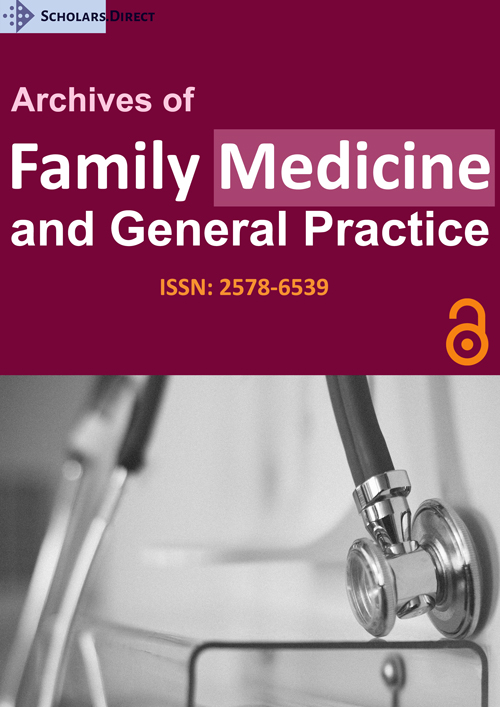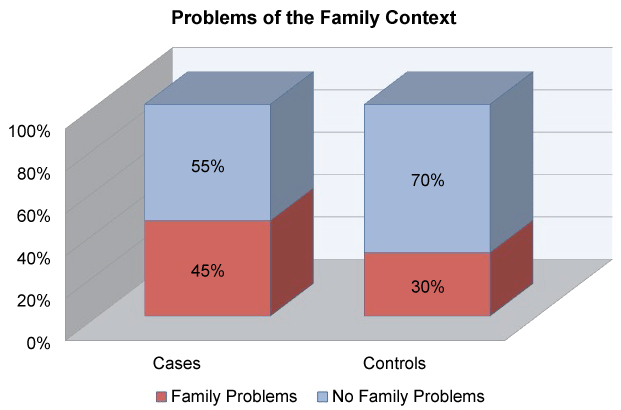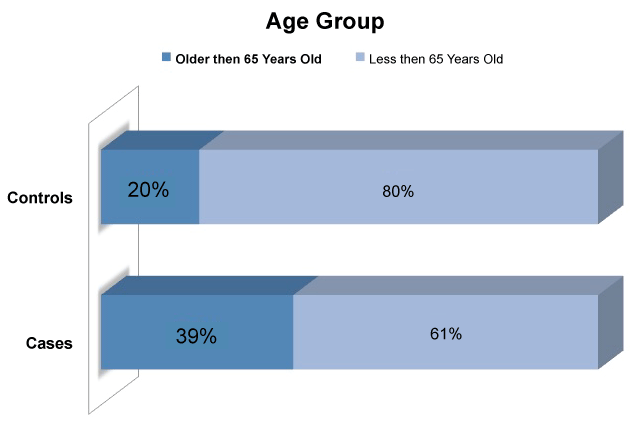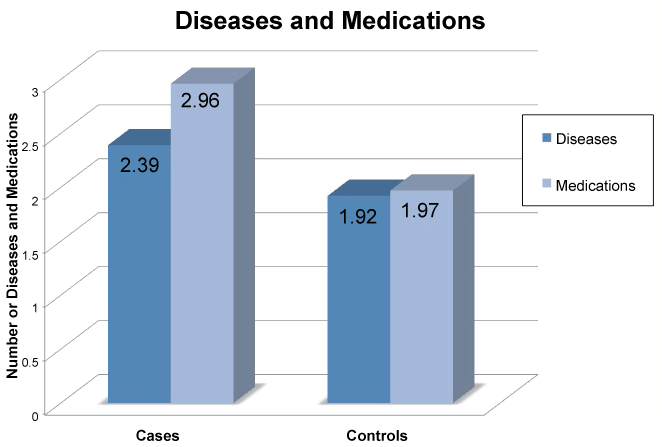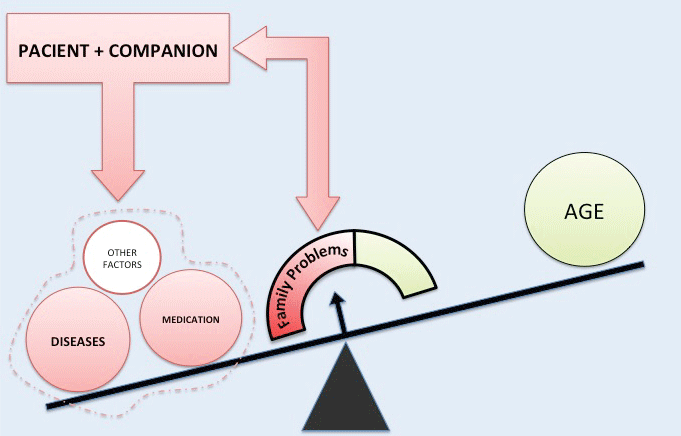The Patient Companion in the Consultation of Family Medical Practice is an Indicator of Hidden Family Problems
Abstract
Objective
Analyze the hypothesis that exposure to family problems results in the presence of a patient companion in the medical consultation.
Material and method
This is a retrospective study of cases and controls. "Case" was defined as a patient with a companion, and "control" as a patient without an accompanying adult. Problems in the family context (based on the genogram) were considered the previous exposure factor. For each case, the patient with the next appointment in the practice who did not come with a companion was chosen as a control. For each patient, the following variables among others were collected: age, sex, chronic diseases, medications, and social class. The bivariate comparisons were performed using the Chi square test, the Student t test, and the Mann-Whitney test. Finally, an analysis using logistical regression was performed.
Results
106 cases and 106 controls were obtained. The cases had more problems in the family context (45.1% vs. 30%; p = 0.03). Significant differences were found in favor of the cases in the following variables: older (≥ 65 years: 38.7% vs. 19.8%), a higher average number of chronic diseases (2.39 vs. 1.92); more drugs prescribed (2.96 vs. 1.97), and lower social class. When the logistical regression analysis was conducted on the variables that showed statistical significance in the bivariate analysis, using as the dependent variable the problems in the family context of the patient, significant differences were found only in the total number of chronic diseases (p = 0.019; OR = 1.384; risk factor), and age (p = 0.024; OR = 0.977; protection factor).
Conclusion
The presence of a patient companion in the consulting room is an indicator of problems in the family context, and should be used as a signal to investigate psychosocial family data.
Keywords
Companion, Caregivers, Family practice, Physician-patient relations, Case-control studies, Retrospective studies, Genogram
Introduction
Family medicine is the medical specialty that provides continuing, comprehensive health care for the individual and family within the context of the community. Providing family-oriented primary care is one of the distinguishing features of this specialty [1-3].
Another important feature of family medicine in individual care is to take into account the presence of companions with the patient [4-11]. However, it is not clear that working with patient companions is included among the attributes of family medicine [12].
Conventionally, physician training focuses on an encounter between two people: the patient and the physician. In practice, a third person (companion) frequently accompanies a patient during medical consultations [13]. A second adult - usually parents or the husband or wife accompanying the patient in the consultation - is always significant and deserves the attention of the doctor. Although many consultations occur with only the patient, others involve patient companions in the consulting room [14].
Routine visits in which one or more family members are present in the consulting room with the patient are frequent. Overall, it is accepted that in about 30% of consultations there is a patient companion, usually family members, especially for elderly patients and children, and the companion can assume important roles in improving the understanding of the patient and doctor [15-18].
However, although clinicians will not be surprised to hear that patients often attend outpatient medical visits with a companion, for example a family member, and it is a common phenomenon in family medicine and other medical areas, even with hospitalized adult patients [19-21], it seems to have not been, in general, a topic of study. Previous research on communication in medical consultations has primarily focused on dyadic interactions between the physician and patient. Consequently, the presence of a patient companion in the medical consulting room and the implications for medical practice has been sparsely studied [22,23].
The exact meaning of consultation with a patient companion is unknown. In addition, patients who are accompanied by a family member are likely to be different from unaccompanied patients, in relation to their health problems, functional abilities, family, relationships, and attitudes toward family involvement in their care.
In this context, the aim of the study was to analyze the hypothesis that exposure to family problems later results in the presence of a companion in the office, and this presence should serve as a signal to investigate further psychosocial and family data of the patient.
Materials and Methods
A retrospective study of cases and controls was realized. "Case" was defined as a patient with a companion, and "control" as a patient without an accompanying adult. Companion was defined as any person who accompanied the patient in the consulting room. The problems in the family context (based on the genogram, and evaluated by the family doctor who performed the genogram at the past time, and who has remained in the same practice for over 25 years, by viewing the family scheme) [24-27] were considered the previous exposure factor. The genogram (schematic model of the structure and processes of a family), included the family structure, life cycle of where that family currently is, important life events, family resources, and family relational patterns.
For each case, the patient with the next appointment in the practice who did not come with a companion was chosen as a control. The location was a family medical practice in the Santa Maria de Benquerencia Health Center, Toledo, Spain, which has a list of 2,000 patients.
From a randomly chosen day, for 15 consecutive days, from November 26, 2015 to December 18, 2015, the visiting patients were included, and data from the case and control were collected. Patients of both sexes over 14 years old were included (family doctors attend patients over 14 years old in Spain).
The sample size for a retrospective case-control study was calculated using a two-sized confidence level (1-alpha) = 95; power (chance of detecting) = 80; ratio of controls to cases = 1 [28]. No estimate of the effect size was conducted specifically. The sample size calculation was performed with the assumption of an expected proportion of exposure in cases of 65%, and controls 40%.
For each case and control the following variables were collected: potential problems in the family context of the patient based on the genogram, age, sex, chronic disease [29] and chief complaint (classified according to ICD-10) [30], taking medication, the therapeutic drug group (classified according to the ATC code or Anatomic Classification, Therapeutic, Chemical system) [31], sick leave of the patient, social-occupancy class (according to the Registrar General's classification of occupations and social status code) [32,33], if an analytical or imaging test was requested for the patient, and if the patient was referred for a consultation with a specialist. Being a retrospective study, the data were collected from the medical records. The informed consent of all the patients or their careers was obtained for the use of group information for the purposes of research.
A Microsoft Excel® file was built as a database, and IBM SPSS Statistics for Windows, Version 18.0. Armonk, NY: IBM Corp [34] was used. Descriptive data, which were expressed by standard measures of central tendency and dispersion, were obtained. The bivariate comparisons were performed using the Chi Square test for percentages, the Student t test for the mean, and the Mann-Whitney test for comparison of means in variables with non-parametric distribution. Finally, an analysis using logistical regression was performed with the "Enter" method, including the variables that showed statistical significance in the bivariate analysis
Results
106 cases and 106 controls were obtained.
Bivariate analysis
The cases had more problems in the family context (45.1% vs. 30%; p = 0.03) (Table 1, Figure 1, Figure 2 and Figure 3).
Significant differences were found in favor of the cases in the following variables
Older (≥ 65 years: 38.7% vs. 19.8%; p = 0.009), higher mean number of chronic diseases (2.39 vs. 1.92; p = 0.023), being significant by groups of diseases in endocrine, nutritional and metabolic diseases, and diseases of the eye and its annexes; more medications taken (2.96 vs. 1.97; p = 0.016), being significant for groups in blood and blood-forming organs and nervous system; and lower social class (p < 0.001).
Logistical regression analysis
In the logistical regression analysis with the variables that showed statistical significance in the bivariate analysis, and using as the dependent variable the problems in the family context of the patient, significant differences were found in the total number of chronic diseases (p = 0.019; OR = 1.384; risk factor; that is, the odds of potential problems in the family context increases 1.384 times for each increase in the number of chronic diseases of the subjects studied), and age (p = 0.024; OR = 0.977; protection factor i.e. for each year of increasing age, the odds of potential problems in the family context decreases 0.977 times).
Possible confounders were identified within which obtained statistically significant differences in the bivariate analysis and were included in the logistic regression model. Variables that are not significant in this analysis are probably confounding variables. They were the total number of consumed drugs and social/occupation class.
The table 2 shows the values of the final model of the logistic regression. The value of R2 Nagelkerke in the logistic regression model is made of 0.071 (the value of -2 log-likelihood is 255.796 and the value of Cox and Snell R2 is 0.052). The value of the Wald statistic of each independent variable included in the model can be seen in the table 2, where the values of the regression coefficients and standard errors are also shown.
Discussion
In practice, family members normally accompany the patient to the consultation, and provide valuable information about the psychological and socio-cultural dimensions of the patient, and personal relationships that contribute to the functional autonomy of the patient, but also they may be associated with conflicts between families and doctors. However, overall, this area of third-party involvement in medical care for adults has not been well studied and the exactly meaning of consultation with a patient companion and his or her contribution to medical intervention and patient involvement are unknown.
The presence of the patient companion in the consultation can be understood as a metaphor in relation to the patient. Metaphors (which include analogies, similes, and models) are cognitive tools by which something unknown is understood in terms of something known. Metaphors (models) are central in family medicine [35]. The patient companion is perhaps his or her "guardian angel", or he or she can be understood as a "listening device" [36].
We found that the presence of a companion is an indicator of potential problems in the context of the patient, and it suggests investigating further psychosocial patient and family data. Previously reported differences in accompanied versus unaccompanied visits may reflect patients’ preferences for being accompanied, the role they wish their companion to play, and the patients’ health status [37]. However, our study is the first that is centered on family problems as a cause of the presence of a patient companion.
We found that patients with a companion were older, with more chronic diseases and taking more drugs, and belonging to a lower social class. These results coincide with those of other studies [38,39].
It is recognized that the presence of a companion can provide a prognostic value: it gives information on the severity of the disease: if the companion is concerned, the doctor should be concerned; if the companion pays little attention to the interview, usually the medical problem is mild [40]. From our study, other prognostic value can be considered: the exposure to family problems is associated with the presence of a patient companion in the consulting room. On the other hand, as in other studies, we found that the number of tests and referrals was not influenced by the presence of a companion [5].
In our study, in the logistical regression analysis, the problems in the family context of the patient were associated with the total number of chronic diseases (p = 0.019; OR = 1.384; risk factor). It is necessary to consider the potentially deleterious impact of chronic diseases (for example, cancer) not just on survivors' spouses, but also on other social network members [41]. The majority of care for older adults with multiple chronic conditions is provided by caregivers within the family (including friends). Although caregivers have reported positive benefits to care giving, they also experience decreases in their physical and mental health [42,43].
However, it is not possible to say if the only factor related to family problems is the chronic disease of the patient. In our study, we did not collect other potentially important factors such as family relationships, social and economic factors, etc. Clearly, more research is needed in this area. However, other authors show concordant results with ours. For example, caregiver burden is a stronger predictor of caregiver depressive symptoms over time than the reverse [44]. The caregiver role can be stressful; because caregivers are at increased risk for depression and anxiety, screening should be carried out to exclude the presence of any disorder [45,46] (Figure 4).
A limitation of our study is that it did not take into account in the controls, the possible confusion of whether the fact that the patient comes unaccompanied was due to not having anyone that could accompany him or her (patient who lives alone, without family or relationships with friends or neighbors). But we think that this situation, if any, must be very rare, and it does not influence the results.
In summary and conclusion, despite the absence of data relating to the international situation in this field, we found that exposure to family problems is associated with the presence of a patient companion in the consulting room. Chronic diseases are a risk factor, and higher age is a protection factor. Thus, the presence of a companion, especially with a younger patient with chronic diseases, is a sign of family problems. The family doctor should look at the patient companion. The companion seems to play a secondary role, but he or she can be the main actor.
References
- AAFP (2016) Definition of Family Medicine.
- Campbell TL, McDaniel SH, Cole-Kelly K, et al. (2002) Family interviewing: A review of the literature in primary care. Fam Med 34: 312-318.
- Turabian JL (1995) Cuadernos de Medicina de Familia y Comunitaria. Una introducción a los principios de Medicina de Familia. Madrid: Díaz de Santos.
- Turabian JL, Perez-Franco B. Modelos de atencion centrada en el "acompañante" del paciente. La familia y el contexto: en el borde de la relacion médico-paciente en medicina de familia.
- Andrades M, Kausar S, Ambreen A (2013) Role and Influence of the Patient's Companion in Family Medicine Consultations: “The Patient's Perspective”. J Family Med Prim Care 2: 283-287.
- Laidsaar-Powell RC, Butow PN, Bu S, et al. (2013) Physician-patient-companion communication and decision-making: a systematic review of triadic medical consultations. Patient Educ Couns 91: 3-13.
- Clayman ML, Morris MA (2013) Patients in context: recognizing the companion as part of a patient-centered team. Patient Educ Couns 91: 1-2.
- Street RL, Gordon HS (2008) Companion participation in cancer consultations. Psychooncology 17: 244-251.
- Greene MG, Majerovitz SD, Adelman RD, et al. (2012) The effects of the presence of a third person on the physician-older patient medical interview. J Am Geriatr Soc 42: 413-419.
- Karnili-Miller O, Werner P, Neufeld-Kroszynski G, et al. (2013) Are you talking to me?! An exploration of the triadic physician-patient-companion communication within memory clinics encounters. Patient Educ Couns 91: 3-13.
- Tsai MH (2005) Opening stages in triadic medical encounters in Taiwan. Commun Med 2: 53-68.
- Jeannie Haggerty, Fred Burge, Jean-Frédéric Lévesque, et al. (2007) Operational Definitions of Attributes of Primary Health Care: Consensus Among Canadian Experts. Ann Fam Med 5: 336-344.
- Schilling LM, Scatena L, Steiner JF, et al. (2002) The third person in the room: Frequency, role, and influence of companions during primary care medical encounters. J Fam Pract 51: 685-690.
- Turabián JL, Pérez Franco B (2015) The presence of a companion in the primary care consultation. Semergen 41: 206-213.
- de la Revilla L, Montoro R, Prados MA, et al. (1993) El acompañante en la entrevista clínica. Aten Primaria 11: 225-227.
- Brown JB, Brett P, Stewart M, et al. (1998) Roles and influence of people who accompany patients on visits to the doctor. Can Fam Physician 44: 1644-1650.
- Main DS, Holcomb S, Dickinson P, et al. (2001) The Effect of Families on the Process of Outpatient Visits in Family Practice. J Fam Pract 50: 888.
- Wolff JL, Roter DL (2011) Family presence in routine medical visits: a meta-analytical review. Soc Sci Med 72: 823-831.
- Souza DibaiI MB, Valadão CadeII N (2009) The experience of patient’s companion at a hospital institution. Rev. enferm. UERJ. Rio de Janeiro 17: 86-90.
- Ortíz AC, Gaviria DL, Palacio ML, et al. (2002) Participación del acompañante en el cuidado del paciente hospitalizado. Instituciones de segundo nivel. Área Metropolitana. Medellín 1999-2000. Investigación y Educación en Enfermería. Medellín 20: 18-29.
- Miller AD, Mishra SR, Kendall L, et al. (2016) Partners in Care: Design Considerations for Caregivers and Patients During a Hospital Stay. CSCW 2016: 756-769.
- Clayman ML, Morris MA (2013) Patients in context: recognizing the companion as part of a patient-centered team. Patient Educ Couns 91: 1-2.
- Ishikawa H, Roter DL, Yamazaki Y, et al. (2005) Physician-elderly patient-companion communication and roles of companions in Japanese geriatric encounters. Soc Sci Med 60: 2307-2320.
- Watts C, Shrader E (1998) How to do (or not to do)… The genogram: a new research tool to document patterns of decision-making, conflict and vulnerability within households. Health Policy and Planning 13: 459-464.
- http://residenciaumf48.weebly.com/uploads/1/3/3/4/13348619/genograma1.pdf
- Báez Montiel B, Turabián Fernández JL (2012) Un genograma “Ufff y Mmmm”. AMF Joven 1.
- McIlvain H, Crabtree B, Medder J, et al. (1998) Using practice genograms to understand and describe practice configurations. Fam Med 30: 490-496.
- Open Source Epidemiologic Statistics for Public Health.
- Strauss AL (1984) Chronic illness and the quality of life. St Louis: The C.V. Mosby Company.
- WHO. (2016) International Classification of Diseases (ICD). ICD-10 ONLINE.
- WHO Collaborating Centre for Drug Statistics Methodology. ATC/DDD Index 2016.
- (1986) Royal Collage of General Practitioners ed. The Classification and Analisis of General Practice Data. Ocasional Paper 26.
- Donaldson RJ, Donaldson LJ (1983) Essential Comunity Medicine. Lancaster: MTP Press.
- Statistical Package for the Social Sciences (SPSS) software.
- Turabian JL, Perez-Franco B (2016) The Family Doctors: Images and Metaphors of the Family Doctor to Learn Family Medicine. Nova Publishers. New York.
- Wholey DR (2014) Using a caregiver, partner, or parent as a “listening device”. BMJ 348: g2516.
- Shields CG, Epstein RM, Fiscella K, et al. (2005) Influence of Accompanied Encounters on Patient-Centeredness with Older Patients. Am Board Fam Med 18: 344-354.
- Del Piccolo L, Goss C, Bottacini A, et al. (2014) Asking questions during breast cancer consultations: does being alone or being accompanied make a difference? Eur J Oncol Nurs 18: 299-304.
- Jansen J, van Weert JC, Wijngaards-de Meij L, et al. (2010) The role of companions in aiding older cancer patients to recall medical information. Psychooncology 19: 170-179.
- Cordella M (2011) A triangle that may work well: Looking through the angles of a three-way exchange in cancer medical encounters. Discourse & Communication 5: 337-353.
- Douglas SL, Daly BJ, Lipson AR (2016) Relationship Between Physical and Psychological Status of Cancer Patients and Caregivers. West J Nurs Res July 38: 858-873.
- Segrin C, Badger TA (2010) Psychological distress in different social network members of breast and prostate cancer survivors. Res Nurs Health 33: 450-464.
- Duggleby W, Williams A, Ghosh S, et al. (2016) Factors influencing changes in health related quality of life of caregivers of persons with multiple chronic conditions. Health Qual Life Outcomes 14: 81.
- Perlick DA, Berk L, Kaczynsky R, et al. (2016) Caregiver burden as a predictor of depression among family and friends who provide care for persons with bipolar disorder. Bipolar Disord 18: 183-191.
- Parks SM, Novielli KD (2000) A practical guide to caring for caregivers. Am Fam Physician 62: 2613-2622.
- Kasuya RT, Polgar-Balley P, Takeuchi R (2000) Caregiver burden and burnout. A guide for primary care physicians. Postgrad Med 108: 119-123.
Corresponding Author
José Luis Turabián, Health Center Santa Maria de Benquerencia, Calderón de la Barca, 24. 45313 Yepes, Toledo, Spain.
Copyright
© 2016 Turabian JL, et al. This is an open-access article distributed under the terms of the Creative Commons Attribution License, which permits unrestricted use, distribution, and reproduction in any medium, provided the original author and source are credited.

